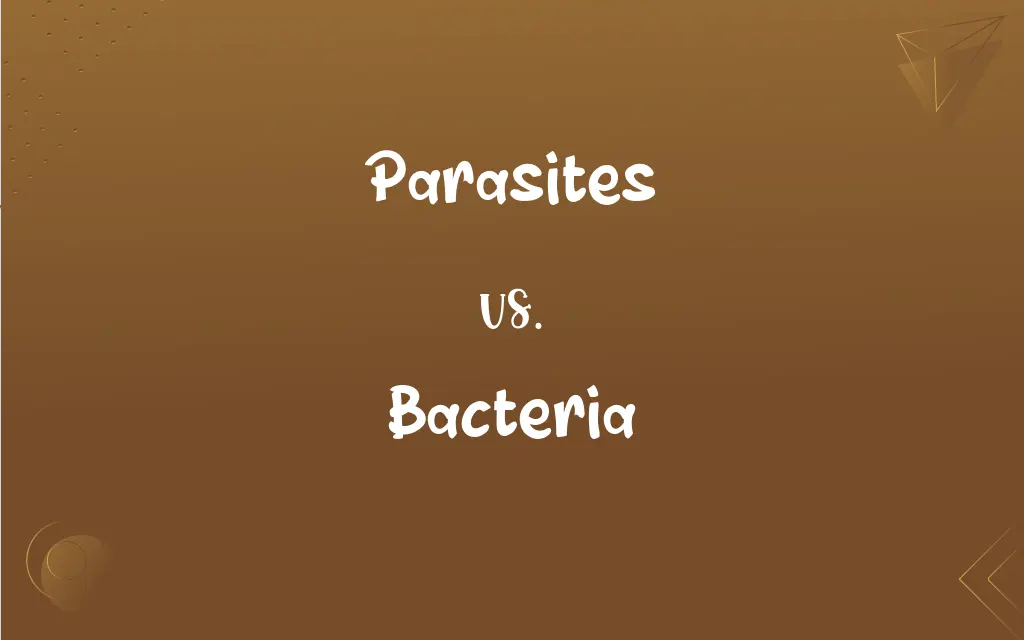Parasites vs. Bacteria: What's the Difference?
Edited by Janet White || By Harlon Moss || Updated on October 20, 2023
Parasites are organisms that live on or in a host, deriving benefits at the host's expense; bacteria are single-celled microorganisms.

Key Differences
Parasites are organisms that establish a relationship in which they benefit by deriving nutrients at the expense of another organism, the host. Bacteria, on the other hand, are microscopic single-celled organisms that can be found in diverse environments.
In terms of classification, parasites can belong to various kingdoms, including Animalia and Protozoa. Bacteria are classified under the kingdom Bacteria (or Monera in some older systems).
Many parasites are multicellular, such as tapeworms and lice, and have complex life cycles. Bacteria are unicellular and reproduce primarily through binary fission.
Parasites can cause diseases like malaria (caused by Plasmodium) or sleeping sickness (caused by Trypanosoma). Bacteria can lead to infections such as strep throat, tuberculosis, and bacterial pneumonia.
Both parasites and bacteria can be pathogenic (disease-causing) or non-pathogenic. Some parasites live in harmony with their hosts without causing harm, and some bacteria play vital roles in processes like fermentation and decomposition.
ADVERTISEMENT
Comparison Chart
Type
Can be unicellular or multicellular
Always unicellular
Kingdom
Varies (e.g., Animalia, Protozoa)
Bacteria (or Monera)
Disease
Can cause malaria, sleeping sickness, etc.
Can cause TB, strep throat, etc.
Reproduction
Often complex life cycles
Primarily binary fission
Role
Derive benefits at host's expense
Diverse roles including beneficial ones
ADVERTISEMENT
Parasites and Bacteria Definitions
Parasites
Entities that benefit at the expense of another.
Some consider certain apps as digital parasites, draining device resources.
Bacteria
Reproduce by binary fission.
Under favorable conditions, bacteria can reproduce rapidly.
Parasites
Can be internal or external in hosts.
Tapeworms are internal parasites found in intestines.
Bacteria
Single-celled microorganisms.
Bacteria in yogurt help in its fermentation.
Parasites
Organisms that live off another organism.
Fleas are parasites that feed on the blood of their hosts.
Bacteria
Can be pathogenic or beneficial.
Some bacteria cause infections, while others aid digestion.
Parasites
Often cause harm to their hosts.
Parasites can weaken plants, making them susceptible to diseases.
Bacteria
Found in diverse environments.
Bacteria exist in soil, water, air, and even extreme conditions.
Parasites
Dependent on their hosts for survival.
Lice are parasites that can't survive long without a human host.
Bacteria
Essential for many ecological processes.
Decomposing bacteria help break down dead organic material.
Parasites
(Biology) An organism that lives and feeds on or in an organism of a different species and causes harm to its host.
Bacteria
Plural of bacterium.
Parasites
One who habitually takes advantage of the generosity of others without making any useful return.
Parasites
One who lives off and flatters the rich; a sycophant.
Parasites
A professional dinner guest, especially in ancient Greece.
Parasites
Plural of parasite
FAQs
Can parasites be beneficial?
While many parasites are harmful, some have mutualistic relationships where both the host and parasite benefit.
What are parasites?
Parasites are organisms that live on or in a host, deriving benefits at the host's expense.
Why are some parasites considered vectors?
Some parasites can transmit diseases between hosts, thus acting as vectors.
Are all bacteria harmful?
No, while some bacteria are pathogenic, many are beneficial or neutral to humans.
Can humans have beneficial bacteria?
Yes, the human gut hosts beneficial bacteria vital for digestion and overall health.
Can parasites infect plants?
Yes, parasites can infect both animals and plants.
Are all bacteria unicellular?
Yes, bacteria are single-celled microorganisms.
Can parasites live independently?
Most parasites are dependent on their hosts for survival, but some stages might survive briefly independently.
How can one protect against parasites?
Protective measures vary by parasite but include personal hygiene, safe water and food consumption, and using repellents.
How can harmful bacteria be treated?
Harmful bacterial infections can often be treated with antibiotics.
How do parasites spread?
Parasites spread through various means, including water, air, vectors, or direct contact.
Can bacteria live in extreme conditions?
Yes, certain bacteria, called extremophiles, thrive in extreme environments.
How do bacteria reproduce?
Bacteria primarily reproduce by binary fission.
Are all parasites microorganisms?
No, parasites can range from microscopic entities to larger multicellular organisms like worms.
What's a common disease caused by parasites?
Malaria is a common disease caused by the Plasmodium parasite.
How do bacteria benefit the environment?
Bacteria play roles in decomposition, nitrogen fixation, and other vital ecological processes.
Are bacteria visible to the naked eye?
Most bacteria are microscopic, but some colonies are visible when they aggregate.
Do all hosts harmed by parasites?
While many hosts are harmed, some coexist with parasites without noticeable harm.
How do beneficial bacteria aid digestion?
Beneficial bacteria break down complex molecules, helping the host to absorb nutrients.
How do bacteria obtain nutrients?
Bacteria absorb nutrients from their environment.
About Author
Written by
Harlon MossHarlon is a seasoned quality moderator and accomplished content writer for Difference Wiki. An alumnus of the prestigious University of California, he earned his degree in Computer Science. Leveraging his academic background, Harlon brings a meticulous and informed perspective to his work, ensuring content accuracy and excellence.
Edited by
Janet WhiteJanet White has been an esteemed writer and blogger for Difference Wiki. Holding a Master's degree in Science and Medical Journalism from the prestigious Boston University, she has consistently demonstrated her expertise and passion for her field. When she's not immersed in her work, Janet relishes her time exercising, delving into a good book, and cherishing moments with friends and family.































































